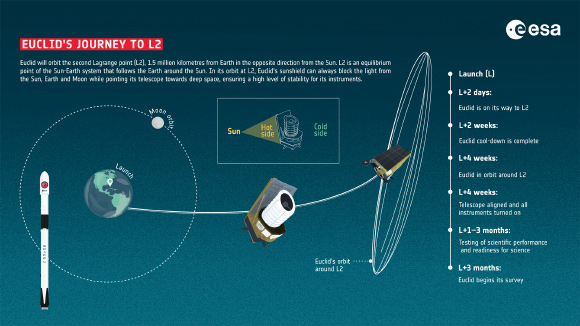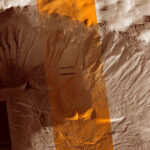The Euclid spacecraft, built and operated by ESA, with contributions from NASA, lifted off from Cape Canaveral Space Force Station in Florida at 11:12 a.m. EDT (17:12 CEST) on July 1, 2023, beginning its mission to study why the Universe is expanding at an accelerating rate. Following launch and separation from the rocket, ESA’s European Space Operations Centre confirmed acquisition of signal from Euclid via the New Norcia ground station in Australia at 11:57 a.m. EDT (17:57 CEST).
Euclid will observe billions of galaxies out to 10 billion light-years to create the largest, most accurate 3D map of the Universe, with the third dimension representing time itself.
This detailed chart of the shape, position and movement of galaxies will reveal how matter is distributed across immense distances and how the expansion of the Universe has evolved over cosmic history, enabling astronomers to infer the properties of dark energy and dark matter.
This will help theorists to improve our understanding of the role of gravity and pin down the nature of these enigmatic entities.
To achieve its ambitious scientific goal, Euclid is equipped with a 1.2-m reflecting telescope that feeds the two innovative scientific instruments: VIS, which takes very sharp images of galaxies over a large fraction of the sky, and NISP, which can analyse galaxies’ infrared light by wavelength to accurately establish their distance.
The spacecraft and communications will be controlled from ESA’s European Space Operations Centre.
To cope with the vast amounts of data Euclid will acquire, ESA’s Estrack network of deep space antennas has been upgraded.
“The successful launch of Euclid marks the beginning of a new scientific endeavour to help us answer one of the most compelling questions of modern science,” said ESA Director General Josef Aschbacher.
“Euclid has been made possible by ESA’s leadership, the effort and expertise of hundreds of European industrial and scientific institutions, and through collaboration with international partners.”
“The quest to answer fundamental questions about our cosmos is what makes us human.”
“And, often, it is what drives the progress of science and the development of powerful, far-reaching, new technologies.”
“ESA is committed to expanding Europe’s ambitions and successes in space for future generations.”
“The Euclid mission is the result of the passion and expertise of those who contributed to designing and building this sophisticated space telescope, the competence of our flight operations team, and the inquiring spirit of the science community,” said Euclid project manager Giuseppe Racca, a researcher with ESA.
“There have been many challenges during the project, but we have worked hard and now we have successfully reached this launch milestone together with our partners in the Euclid Consortium and NASA.”
ESA’s Euclid spacecraft will orbit the second Lagrange point (L2), 1.5 million km from Earth in the opposite direction to the Sun. L2 is an equilibrium point of the Sun-Earth system that follows Earth around the Sun. In its orbit at L2, Euclid’s sunshield can always block the light from the Sun, Earth and Moon while pointing its telescope towards deep space, ensuring a high level of stability for its instruments. At L2, Euclid joins ESA’s Gaia mission and the ESA/NASA/CSA James Webb Space Telescope, which are also orbiting around this equilibrium point, each following well separated trajectories. Image credit: ESA.
“We are thrilled about the successful launch of ESA’s Euclid mission and are eager to see the science it returns,” said Nicola Fox, associate administrator for NASA’s Science Mission Directorate.
“By studying the ‘dark side’ of our Universe, Euclid is not only paving the way for NASA’s Roman Space Telescope, it is igniting a new golden age of survey astronomy that will help us understand our Universe’s history and structure in ways that were not possible before.”
“Today we celebrate the successful launch of a ground-breaking mission that places Europe at the forefront of cosmological studies,” said Carole Mundell, ESA’s Director of Science.
“If we want to understand the Universe we live in, we need to uncover the nature of dark matter and dark energy and understand the role they played in shaping our cosmos.”
“To address these fundamental questions, Euclid will deliver the most detailed map of the extragalactic sky.”
“This inestimable wealth of data will also enable the scientific community to investigate many other aspects of astronomy, for many years to come.”
“This is a great moment for science, one that we have long been looking forward to: the launch of Euclid, on a mission to decipher the puzzle of dark matter and dark energy,” said Euclid project scientist René Laureijs, a researcher with ESA.
“The big mystery of the fundamental constituents of the Universe is staring us in the face, offering a formidable challenge.”
“Thanks to its advanced telescope and powerful scientific instrumentation, Euclid is poised to help us unravel this mystery.”
In the next four weeks, Euclid will travel towards Sun-Earth Lagrange point 2, an equilibrium point of the Sun-Earth system located 1.5 million km from Earth (about four times the Earth-Moon distance) in the direction opposite from the Sun.
There, Euclid will be manoeuvred into orbit around this point and mission controllers will start the activities to verify all the functions of the spacecraft, check out the telescope and finally turn on the scientific instruments.
Scientists and engineers will then be engaged in an intense two-month phase of testing and calibrating Euclid’s scientific instruments and preparing for routine observations.
Over six years Euclid will survey one third of the sky with unprecedented accuracy and sensitivity.



